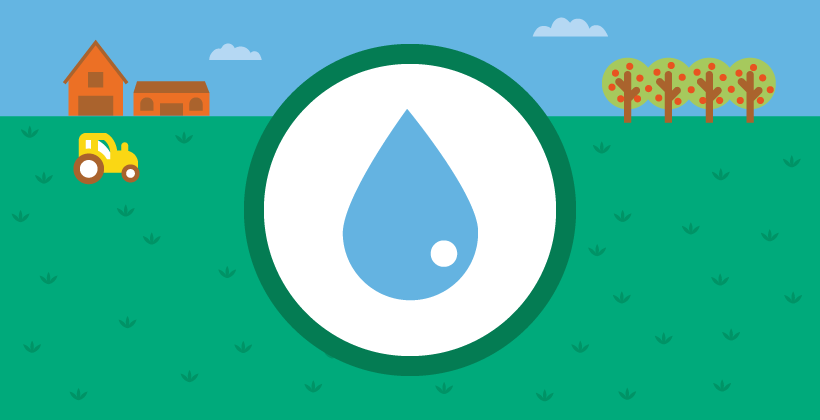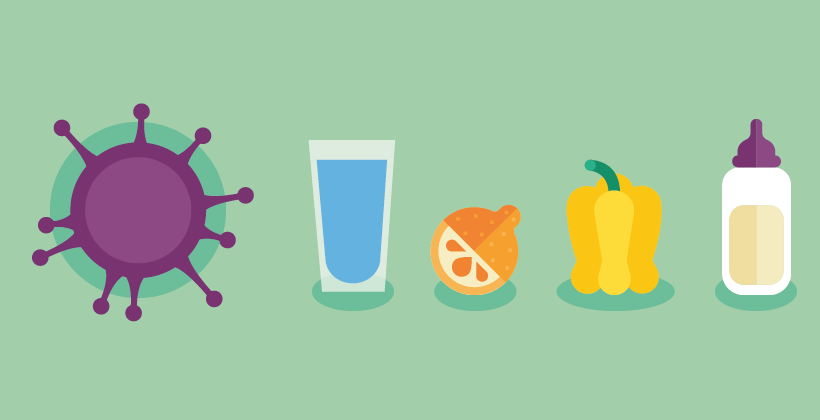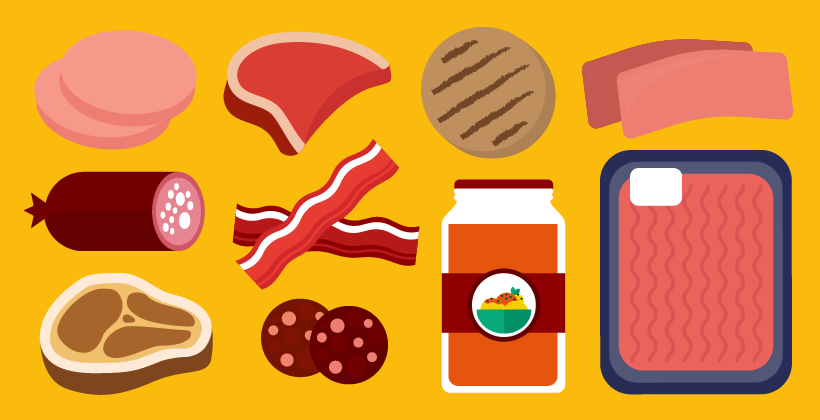Dive into the world of vitamins and minerals
Last Updated : 11 January 2021Every day, our bodies work around the clock orchestrating thousands of different tasks that keep us alive and functioning well. These range from continuously delivering enough oxygen to our cells, to making sure that our immune system is ready to fight potentially harmful invaders.
To carry out all its functions, our body need specific nutrients that come from the foods we eat. While most of our bodies’ fuel and building blocks are provided by so-called macronutrients (carbohydrates, fats and proteins), each particular function and process requires a delicate balance between tiny amounts of other nutrients, called micronutrients.
What is the difference between macro- and micronutrients?
Macronutrients (carbohydrates, fats and proteins) are called ‘macro’ because we need them in large amounts. Our bodies rely on macronutrients as their main source of energy (calories) and for structural and metabolic roles. For instance, proteins make up the building blocks of our muscles and fats are essential to develop and keep the healthy function of our brains.
Water is also considered a macronutrient; however, it’s a special case. This is because even though we don’t get energy (calories) from water, we still need it in large amounts to keep alive and healthy.
Micronutrients are commonly known as vitamins and minerals. They’re nutrients that our body needs in tiny amounts to function properly. Unlike macronutrients, micronutrients don’t provide energy but take the lead in many of the functions that maintain our health. Those include helping our bodies produce energy, keeping our immune system functioning well, and maintaining the health of our skin, muscles and bones. Because our bodies can't produce most vitamins and minerals – or at least not in sufficient amounts to cover our needs – we need to get them regularly through our diets.1
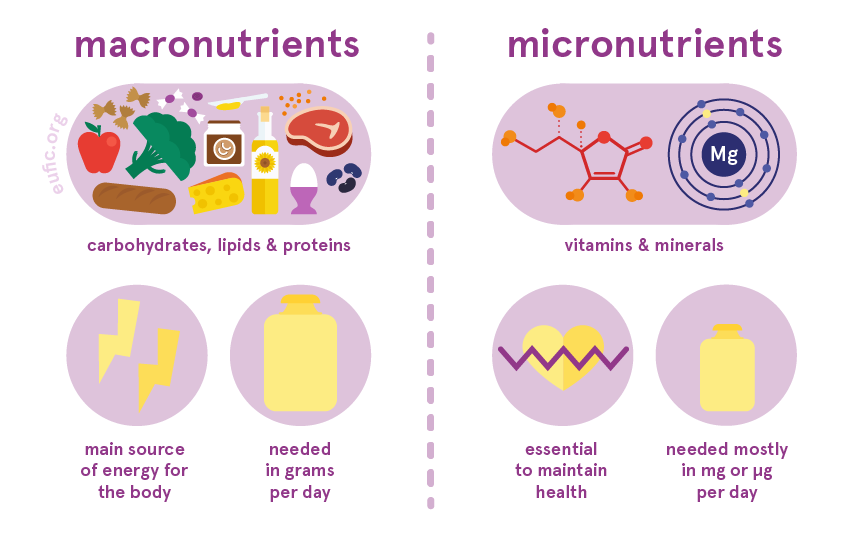
So, how can we tell the difference between a vitamin and a mineral and what are their main roles in our bodies?
What are vitamins?
Simply put, vitamins are organic compounds produced by bacteria, plants and animals, which are essential to human health. The name itself comes from the Latin word “vita”, which means life.
Out of the 14 necessary vitamins, our bodies can produce 3 of them - vitamin D, niacin and choline – however, not in amounts that allow us to be self-sufficient. Thus, we still need to include all vitamins in our diet. Vitamins can be classified as water- or fat-soluble, depending on their ability to dissolve in water or fat, respectively. This in turn affects the way they’re absorbed, transported and stored in the body. 1,2
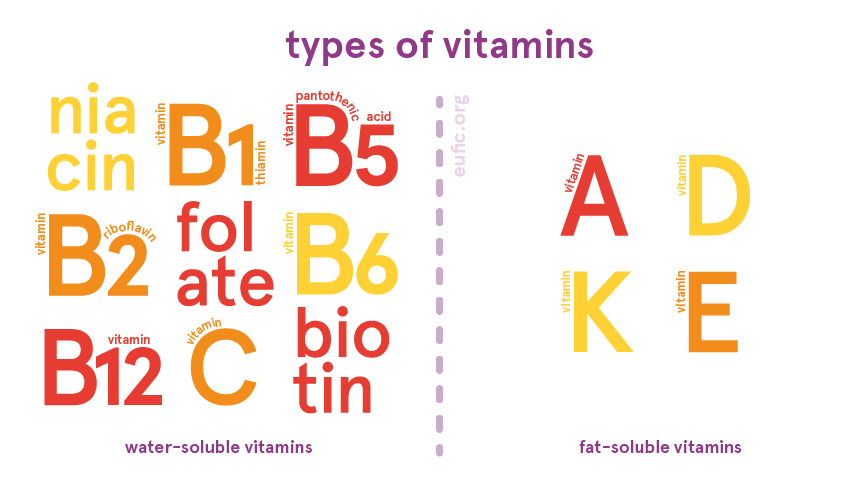
Water-soluble vitamins are present in the watery parts of the food we eat and are easily absorbed into our bodies. Our bodies can’t store most water-soluble vitamins for long periods and quickly remove any excess through urine, except for vitamin B12, which we can store in significant amounts in our liver and kidneys. 1
Fat-soluble vitamins dissolve in fats and oils, thus are abundant in foods rich in fats such as vegetable oils, fatty fish or full-fat dairy. In turn, fat-soluble vitamins from vegetable sources are usually better absorbed when paired together or cooked with fat-rich foods. Contrary to water-soluble vitamins, our bodies can store some of these vitamins in the liver and fat tissues and use them as needed.1,2
Water-soluble vitamins have a key role in helping our bodies convert the different foods we eat into energy that can be used by our cells. They are also involved in the proper functioning of our nervous system and they help our cells multiply while protecting our genetic material (DNA) in the process. 1,2
As for the four fat-soluble vitamins, while they’re involved in many important functions, they each have a starring role in the body. For example, vitamin A is important for normal vision; vitamin D helps regulate the levels of calcium and phosphorus in the body; vitamin E has a key role in protecting cells from free-radicals and vitamin K is essential for blood clotting. 1,2 You can find more about the specific roles of each vitamin here.
What are minerals?
There are many minerals in nature, however, our bodies only need 14 of them to survive. Minerals are inorganic compounds that originate from non-living matter, such as rocks, soil, or water. We get them in our diet directly through water, or indirectly through eating plants and animal-based foods, when they absorb it from the environment or through the food chain.
We can divide essential minerals in major minerals or trace elements, depending on their chemical structure and how much we need them in our diets.
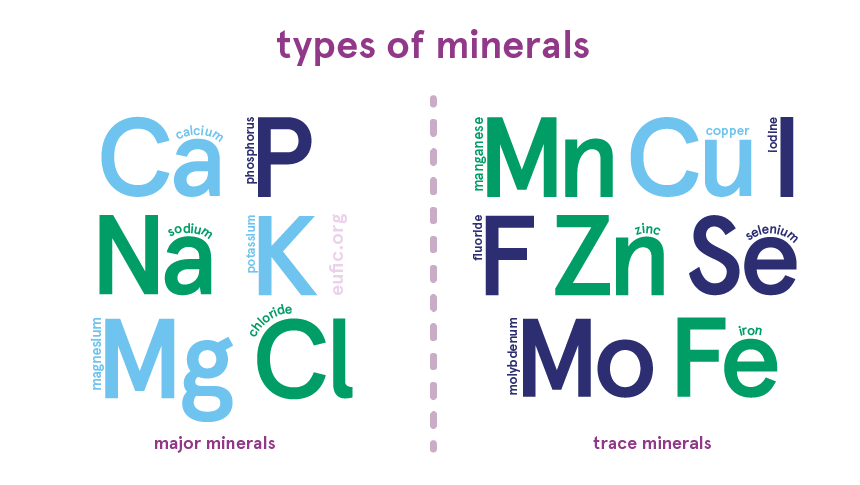
- Major or macro-minerals are needed in relatively large amounts, usually above 200 mg, or even a few grams per day, to keep our health.
- Trace elements, sometimes also referred to as micro-minerals, are needed in much smaller amounts, usually below one milligram (micrograms), or a few milligrams mg per day, to keep our health.
Same as vitamins, both macro and micro minerals share a set of vital tasks in the body. Major minerals are usually involved in structural and regulatory functions. For example, calcium, magnesium and phosphorus help form and keep the structure of our bones and teeth. In turn, sodium and potassium have a key role in balancing our bodies’ fluids and in helping control the transport of compounds and nutrients in and out of cells. 1,2
Trace minerals, on the other hand, are particularly important to support the function of different enzymes in our bodies, while also having key roles in our metabolism and immune function. You can find more about the specific roles of each mineral or trace element here. 1,2
How do vitamins and minerals work in the body?
It’s common to look at micronutrients as individual players, but it’s their continuous interactions that allow us to thrive. In fact, despite their differences, vitamins and minerals often work together to perform specific tasks in our bodies. Take vitamin B12 and folate for example. This precious duo works together to create healthy blood cells. But without iron or phosphorus and chloride, the oxygen from the lungs could not hop on (and off) the red blood cells to be delivered around the body. 2,3,4
In other cases, micronutrients team up in unexpected advantageous ways. For example, vitamin C can give our gut a helping hand to absorb the iron from plant-based foods, which we naturally absorb less than the iron from animal products. 2
However, the opposite dynamics can also happen, too much of a specific micronutrient can hinder levels of another, either by competing for absorption or by pushing the other to be removed out of the body. For example, a diet high in table salt (i.e. sodium chloride) can reduce the level of calcium in our bodies, as calcium binds to sodium to help the body get rid of the salt surplus. As so, respecting the recommended amounts of salt in our diets, is important not only to lower the risk of cardiovascular diseases but also to protect the health of our bones. 5
Considering that virtually every single function in our bodies depends on a good balance of several vitamins and minerals, ensuring the right amounts is key. But how much of each micronutrient do we need and what happens if we fall far below or above the recommended amounts?
How much of each micronutrient do we need?
How much of each vitamin and mineral we need to keep healthy depends on our age, sex and physiological state (i.e. during pregnancy or lactation). The values that guide nutrient recommendations are known as the dietary reference values (DRVs).6
Simply put, DRVs estimate how much of each nutrient, on average, is needed on a daily basis to support the adequate growth, development and health of healthy population groups. However, DRVs should not be interpreted as nutrient goals; they are used by professionals to provide nutritional advice to specific individuals or groups (read more about DRVs here).6
Countries use DRVs to set their nutritional recommendations which also account for other factors such as the traditional diet of the country or the duration of sunlight. 7 Hence, following your country’s dietary guidelines is the safest way to meet your vitamins and minerals needs, without risking having too little or too much of them.
So, what happens if we have too little or too much of a specific vitamin or mineral?
What happens if we have too little (a.k.a. deficient levels) of a specific micronutrient?
A vitamin or mineral deficiency happens when the recommendation for the respective micronutrient is not met over a long period of time. This usually results in specific health problems, which can often be solved by restoring the levels of the micronutrient in the body. 1,2 For example, low levels of iron prevent our bodies from producing enough red blood cells to keep us healthy, which leads to a condition called anaemia. Anaemia is the world’s most common disorder caused by a nutritional deficiency. It’s particularly concerning during pregnancy and childhood, as it can seriously impair the child’s growth and development. 7
There can be other reasons for a deficiency to occur besides a low intake from diet. In some cases, it can be related to health conditions that affect the absorption of nutrients in the gut, such as Crohn's disease, coeliac disease, severe episodes of diarrhoea or vomiting, or chronic alcohol abuse. Other times, it can also be caused by genetic disorders or the use of medications that affect the levels of specific micronutrients in our bodies. 1,2
Some people are more vulnerable to vitamin and mineral deficiencies, due to higher needs or lower chances of getting them through the foods they eat. While it’s important to have a good balance of all the micronutrients in our diets at all ages, there are some phases when low intakes can affect us more. Those include:
Infancy and childhood
Our early years are a period of rapid growth and development which are supported by specific amounts of vitamins and minerals. Micronutrient deficiencies during this period are particularly concerning, as they can impair the healthy growth and development of the child in the long-term. Some key vitamins and minerals to pay extra attention to during infancy and childhood include vitamin A, vitamin D, iron, calcium, iodine and zinc. 2
From the onset of menstruation to menopause
People who menstruate need extra iron in their diets to compensate for the monthly losses in menstruation blood. Thus, it’s particularly important that they have a healthy diet that includes good sources of iron. Vegans and vegetarians need to pay extra attention and also include enough sources of iron in their diets since iron from plants is less absorbed than iron from animal products. 2
Pregnancy and lactation
During pregnancy, there is a higher need for most vitamins and minerals to support the healthy development of both the mother and the baby. For those planning a pregnancy, folate supplementation is usually recommended up to a month before conception. This is because proper levels of this vitamin, before and during the early stages of pregnancy, is essential to prevent complications in the development of the baby. During pregnancy, is also important to pay extra attention to the intake of vitamin A, iron, iodine and zinc since a deficiency in this phase could be harmful to the development of the baby. 2 However, a balanced diet and pre-natal vitamins usually covers all the pregnancy needs.
During lactation, there’s also the need for extra amounts of specific micronutrients to compensate for losses through breastmilk. Some important ones include vitamin A, iodine, iron, and zinc..
During old age
With aging, our bodies’ ability to take up micronutrients decreases and specific health conditions, such as loss of appetite and difficulty in eating, gastric problems and others, put the elderly at risk of not getting enough of some micronutrients. A few ones to pay attention to include calcium, vitamin D and vitamin B12.
When diets rarely include animal products
Vegans, vegetarians or those who rarely consume animal products (such as meat, fish, eggs and dairy) might need vitamin B12 supplementation as they have very few - or none – dietary sources of this vitamin, which is essential for the normal functioning of our brains and nervous system. Those could also risk insufficient intakes of iodine, zinc, iron, vitamin D and riboflavin as these micronutrients are either more commonly found in animal products (iodine, riboflavin and vitamin D) or better absorbed from them (zinc and iron). 2
When living in countries with low sun exposure or for people with darker skin
Vitamin D can be produced in our skin when exposed to sunlight, putting those who live in countries with short sun periods at higher risk of deficiency. Similarly, people with darker skin produce less of this vitamin due to the higher amounts of the pigment melanin in the skin. 2
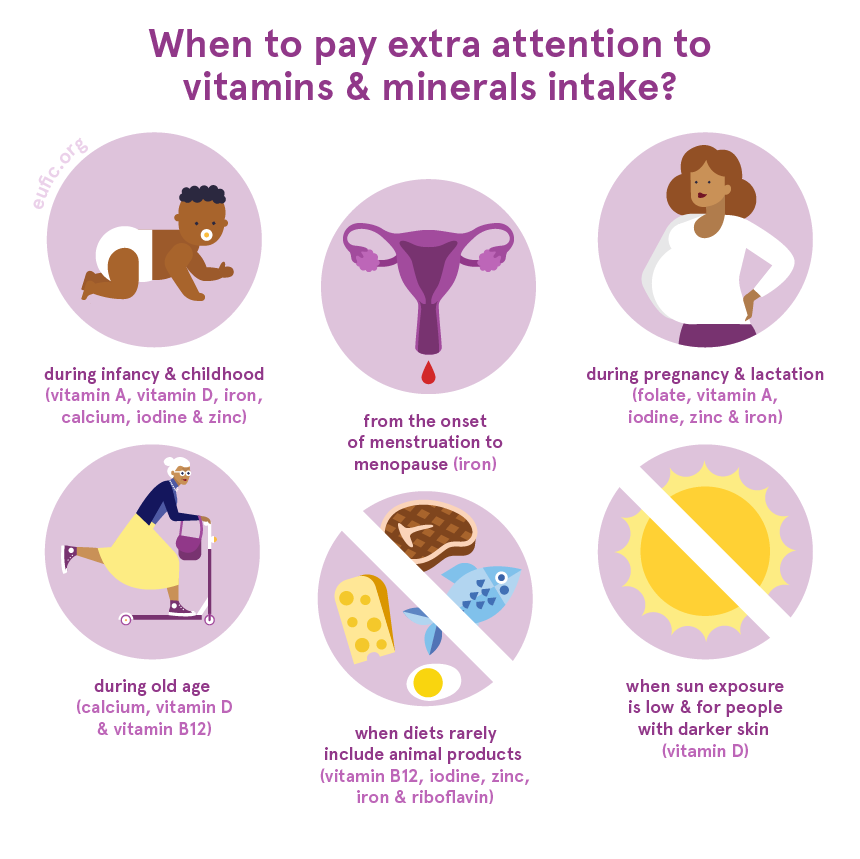
Most people can get the recommended amounts of vitamins and minerals by having a varied and balanced diet rich in nutrient-dense foods. However, if we regularly eat foods high in energy but low in vitamins in minerals, we risk meeting – or even exceeding – our energy needs (calories) without getting enough micronutrients. Over time, these insufficient intakes of vitamins and minerals will turn into deficiencies and increase the risk for different diseases. 2
If you are planning to change your diet, have recently done so, or are concerned that you might not be getting enough vitamins and minerals, we recommend that you consult a qualified nutritionist or dietitian to discuss how to best meet your own nutritional needs.
What happens if we have too much (a.k.a. toxic levels) of a specific micronutrient?
On the opposite extreme of deficiency is toxicity, when the amount of a micronutrient goes far beyond what our bodies can process. For most vitamins and minerals there is a maximum value for intake, above which negative (toxic) effects can occur, particularly when consumed over a long period of time. Professionals refer to these values as Tolerable Upper Intake Levels (UL). 6
Not all micronutrients have a defined UL, but that doesn’t mean that consuming them in large doses is harmless. Even micronutrients that have a lower risk of toxicity (such as water-soluble vitamins,) can still cause harmful effects when taken in amounts that go above and beyond recommendations.
Toxic levels of micronutrients are more easily reached through supplements than foods, particularly in the case of minerals and fat-soluble vitamins. 1,2 While supplementation can be a helpful way to help specific groups fill in the gap for some micronutrients, before supplementing we should take care to ensure that we’re meeting our needs without exceeding the recommendations.
How to get enough micronutrients?
Our diet should be our main source of micronutrients. Vitamins and minerals are naturally present in a variety of nutrient-dense foods such as fruits, vegetables, nuts, pulses, whole grains, vegetable oils, fish, meat, and dairy. Since no single food contains the full spectrum of micronutrients, the key to a healthy diet is to ensure a good balance and variety of these foods on a regular basis.
However, there are other things we should keep in mind when aiming to improve our intakes of vitamins and minerals:
1. Mix up the ways you prepare, cook and eat your foods
The way we prepare and cook our foods affects the total amount of micronutrients available for absorption, compared to when they’re raw. While some nutrients can be reduced, others can become better absorbed by the body. For example, vegetables rich in water-soluble vitamins (such as the B-vitamins and vitamin C) and minerals usually keep higher amounts of these micronutrients when they’re steamed than when they’re boiled. In turn, cooking can make fat-soluble vitamins present in some vegetables – such as carotenoids (vitamin A) in carrots or vitamin K in spinach – become more available for absorption, particularly if small amounts of fat-rich foods, such as olive oil, are added.
Storing our foods correctly is also important since some micronutrients - particularly vitamins – can lose their function if exposed to light and oxygen for long periods. 9
2. Pay attention to food labels
When you’re looking for foods high in vitamins and minerals, pay attention to food labels. Foods labelled as “rich/high in” a specific micronutrient must contain at least 30% of the recommended daily dose for that nutrient in 100 g or in a standard portion of those foods. 10 However, this alone is not enough to regard them as nutritious food and their overall nutritional value must be put into context. For example, if those foods are at the same time high in fat, sugar or salt, they might not be your best choice.
3. Consider fortified foods
Fortified or enriched foods are foods that have been added with significant amounts of specific nutrients (usually, at least 15% of the recommended daily dose of a micronutrient per 100 grams or milliliters). 10 These foods can be a good way to help us consume more vitamins and minerals, particularly for those who have excluded specific foods from their diets (vegans, people with allergies or coeliac disease, etc.).
4. Supplement if needed, but with caution
In some cases, the diet alone is not sufficient to provide us with the recommended amounts of specific micronutrients and supplementation is advised to prevent us from getting insufficient levels or a deficiency.
Before adding supplements to your diet, check with your health care professional or consult your national guidelines to assess your individual needs. And remember, supplements will not compensate for an unhealthy diet!
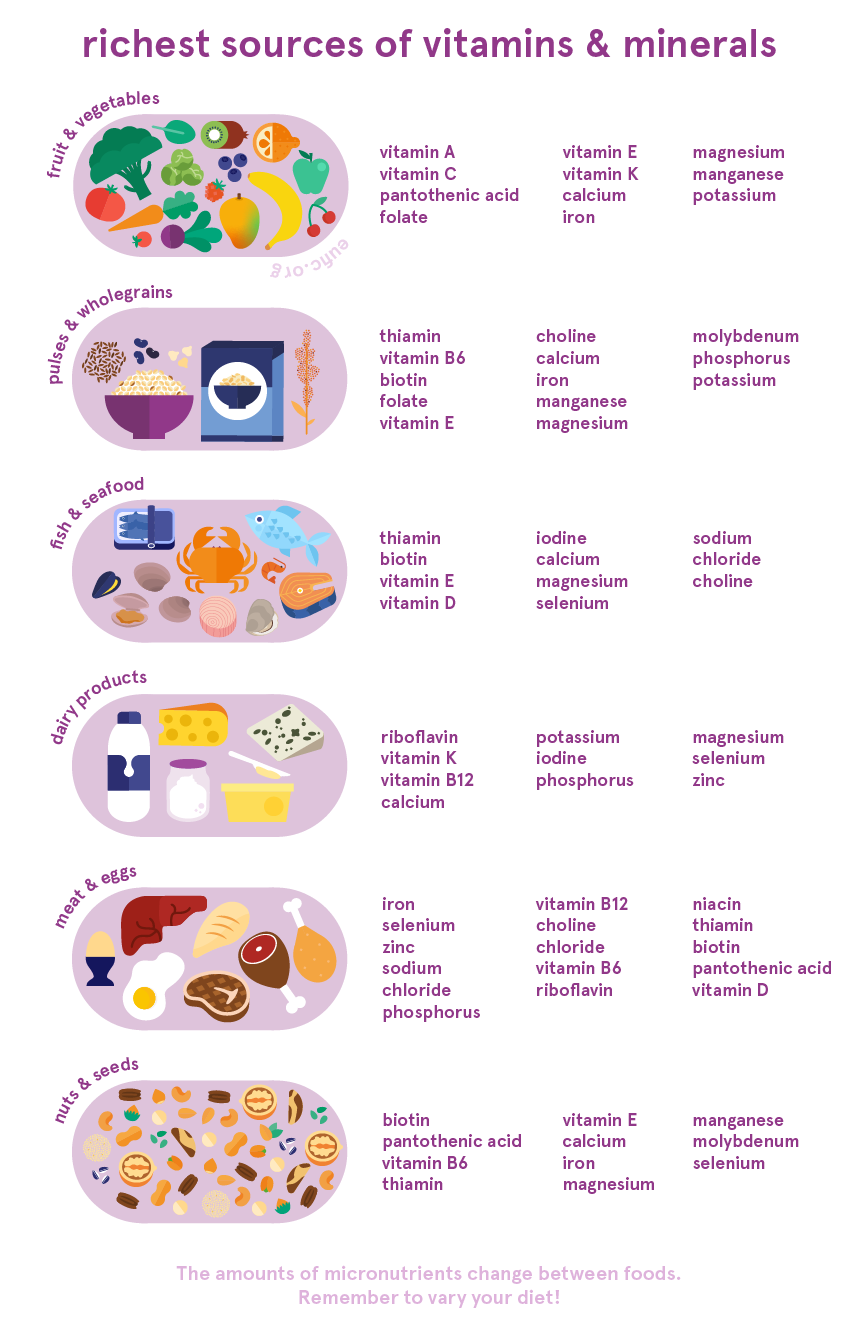
Explore the vitamins and minerals database!
Now that you have been introduced to the basics of micronutrients, it’s time to explore each one of them in more detail. In this database, you will find all the information on the essential vitamins and minerals in our diet, including their roles in our bodies, the recommended amounts, in what foods we can find them, and what happens if we have too little or too much of them. You can then test your newly gained knowledge by doing this quiz!
References
- Bender A.D. 2015. Micronutrients: Vitamins & Minerals. In: Rodwell, W.V., Bender, A.D., Botham, M.K., Kennelly, J.P. and Weil, A. P. 2015. Harper's Illustrated Biochemistry. 30th edition. McGraw-Hill Education, pp 546-563.
- World Health Organization (WHO). 2004. Vitamin and mineral requirements in human nutrition. 2nd edition. Geneva, Switzerland: WHO.
- European Food Safety Authority. 2015. Scientific Opinion on Dietary Reference Values for phosphorus. EFSA Journal 2015;13
- European Food Safety Authority. 2019. Scientific Opinion on dietary reference values for chloride. EFSA Journal 2019;17(9):5779
- European Food Safety Authority. 2015. Scientific Opinion on Dietary Reference Values for calcium. EFSA Journal 2015;13
- European Food Safety Authority. 2010. Scientific Opinion on principles for deriving and applying Dietary Reference Values. EFSA Journal 2010; 8(3):1458
- Doets E.L. et al., 2008. Current micronutrient recommendations in Europe: towards understanding their differences and similarities. European Journal of Nutrition; 2008;47(1)
- European Food Safety Authority. 2015. Scientific Opinion on Dietary Reference Values for iron. EFSA Journal 2015;13(10):4254
- Platel, K., and Srinivasan K. 2015. Bioavailability of Micronutrients from Plant Foods: An Update. Critical Reviews in Food Science and Nutrition, 56(10), 1608-1619
- Regulation (EC) No 1925/2006 of the European Parliament and of the Council of 20 December 2006 on the addition of vitamins and minerals and of certain other substances to foods.





